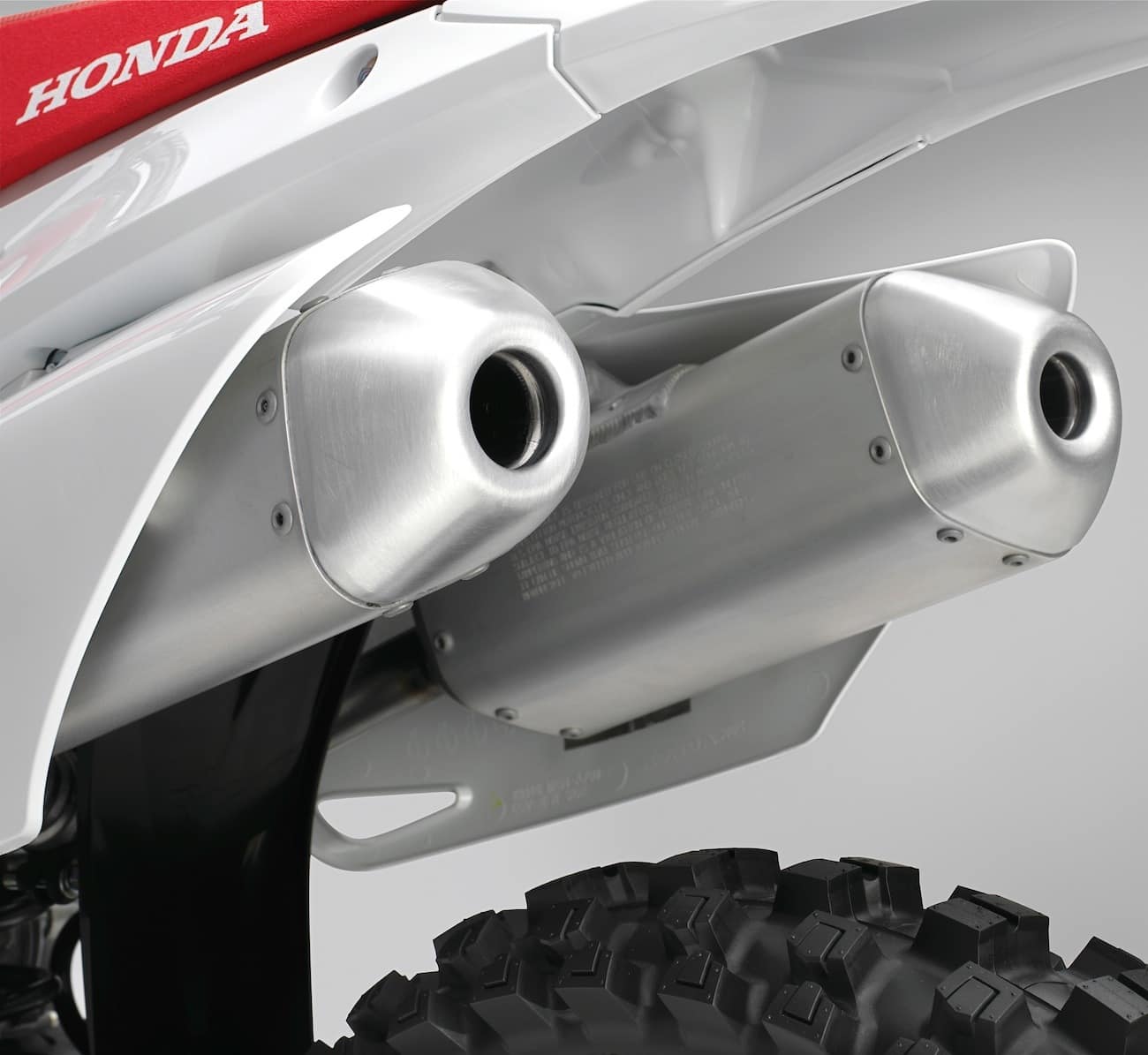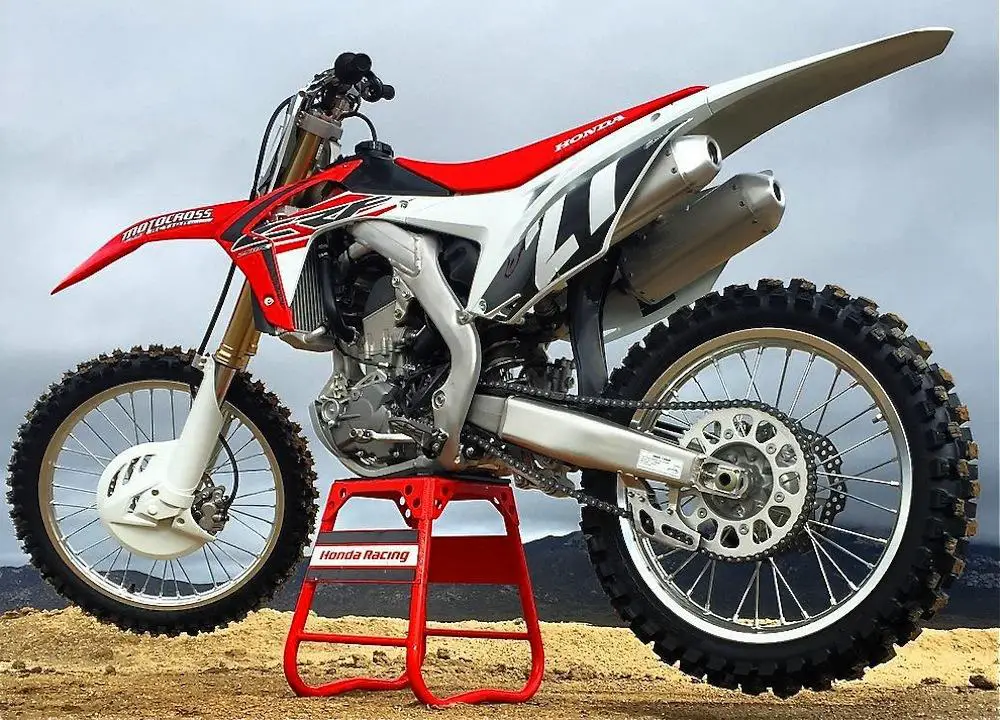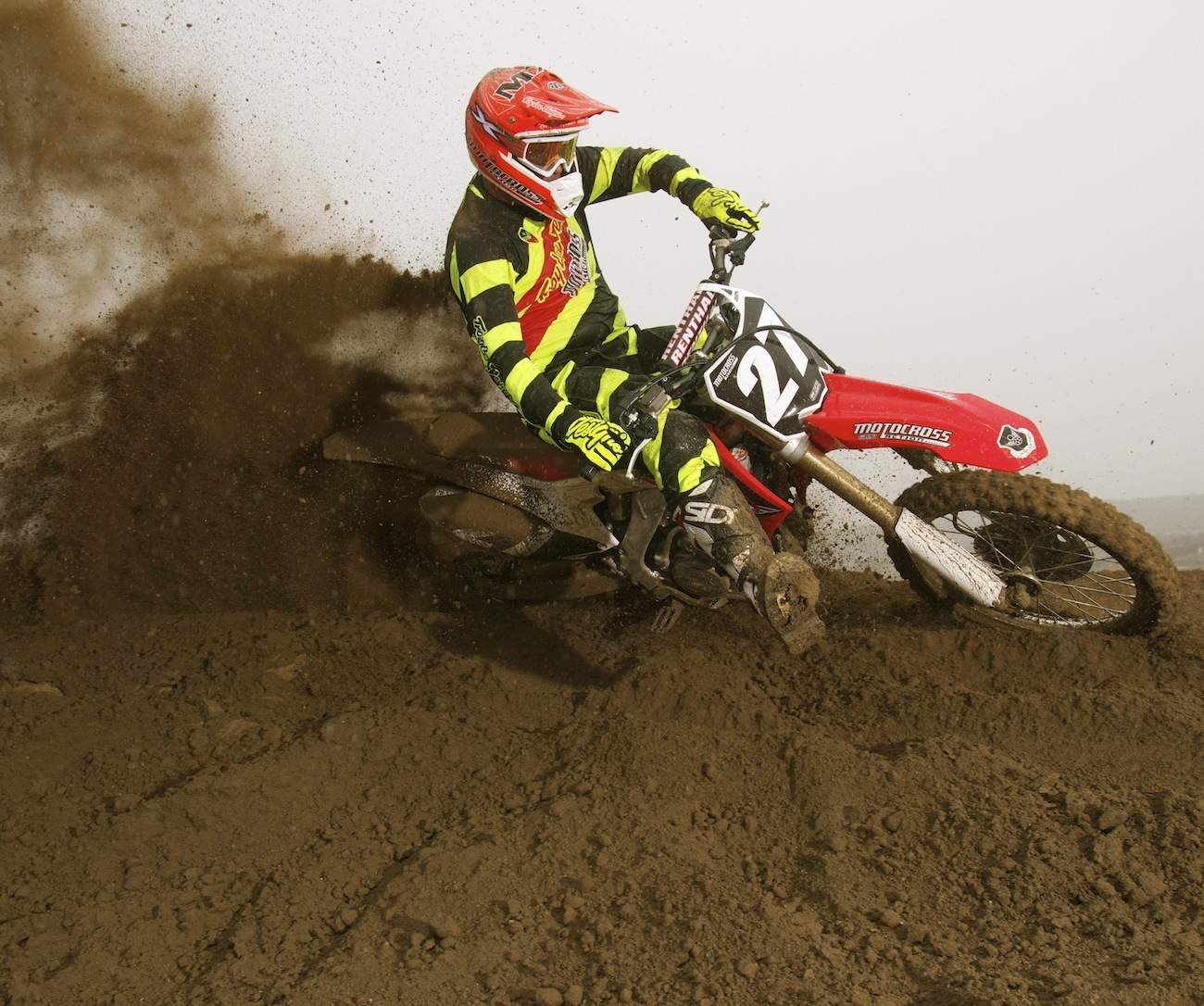2016 HONDA CRF250 MXA RACE TEST: EVERYTHING YOU NEED TO KNOW
Q: FIRST AND FOREMOST, IS THE 2016 HONDA CRF250 BETTER THAN THE 2015 CRF250?
A: Yes. Honda made some solid improvements to the 2016 CRF250, most notably in top-end power and suspension compliance; however, Honda’s 2016 mods seem a little like closing the barn door after the horse has bolted.
Q: HOW MANY CHANGES DID HONDA MAKE TO THE 2016 CRF250?
A: Honda didn’t rest on its laurels with the 2016 CRF250, largely because the lowly 2015 CRF250 didn’t have any laurels. It was a mid-pack finisher in the “2015 MXA 250 Shootout.” So, Honda spent time and money working on the 2016 engine and suspension.
(1) Engine. To increase power for 2016, Honda made a number of changes to the CRF250 engine, including lightening the piston and connecting rod, switching to titanium exhaust valves, revising the intake and exhaust port shapes, upping the valve lift, DLC-coating the buckets, adding an exhaust resonator to the head pipe, increasing the diameter of the muffler’s perf core, bumping up the compression (from 13.5:1 to 13.8:1), revising the air-boot shape between the filter and throttle body, putting a roller bearing on the shift-drum stopper and increasing the fluid capacity of the left radiator.
(2) Chassis. The frame and its accoutrements remain unchanged except for the longer fork legs, new anti-mud footpeg scrapers and a 4mm-smaller-diameter chain roller (34mm instead of 38mm).
(3) Forks. For 2016 the CRF250 retains Showa’s Separate Function Fork Triple Air Chamber units (SFF TAC in acronym-speak). The forks have more in common with the Kawasaki version of the TAC forks than the Suzuki RM-Z450 forks but differ from both in that:
(a) Lefty: They don’t house the air pressure in the right fork leg but in the left one instead.
(b) Clickers: With the air on the brake-side fork leg, the damping and clickers are on the right fork leg.
(c) Hidden chamber: They don’t use a piggyback balance chamber but instead tuck the balance chamber inside the left fork leg with both the main and outer chambers.
(d) Schrader valve: Last year Honda didn’t put a Schrader valve on the outer chamber, or recommend any pressure in it, but this year there is a Schrader valve and an air pressure recommendation.
(e) Mellow breeze: Compared to the 2015 fork settings, the air pressure has been reduced for a suppler feel.
(f) Daddy long legs: The 2016 fork legs are 5mm longer than the 2015 legs, but this was done more for the 2016 CRF450 than for the CRF250.
(g) Incremental: The clicker adjustments have been made more incremental (it now takes eight clicks to do what four did last year).
 2016 Honda CRF250: The massaged 2016 CRF250 engine produces more power on top and a modest increase in peak horsepower.
2016 Honda CRF250: The massaged 2016 CRF250 engine produces more power on top and a modest increase in peak horsepower.
Q: WHAT IS THE MOST NOTICEABLE CHANGE TO THE 2016 HONDA CRF250?
A: The major difference between the 2016 Honda CRF250 and the 2015 CRF250 is in the top-end power. Last year the CRF250 engine was a mixed bag. The power was manageable but not abundant. The power delivery was nice from low to mid but flat on top. The 2015 CRF250 engine was the perfect 250 Novice powerband. In plain language, it was slow, didn’t rev and lacked serious horsepower. It fit perfectly into Honda’s very strange “slow and steady wins the race” corporate philosophy. It should be noted that “slow and steady” also loses shootouts and sales.
Short of designing a new engine, which is hopefully on the Honda engineers’ wish list, Honda pulled out all the stops with mods to the 2016 mill (piston, valves, rod, buckets, compression and valve lift). And while you can’t always turn a sow’s ear into a silk purse, you can gussy it up a fair bit. And that is what Honda achieved with the 2016 CRF250. Honda managed to add top-end power and over-rev without giving all of the low and mid back. This is commendable, mostly because it is almost impossible to do successfully.
Q: HOW DOES THE 2016 HONDA CRF250 RUN ON THE DYNO?
A: Which do you want first? The good news or the bad news? Excellent choice.
The good news. Compared to the 2015 Honda CRF250, the 2016 CRF250 makes 1.6 horsepower more at peak. Better yet, from 10,000 rpm on it gaps the 2015 model by leaps and bounds. At 10,000 rpm the 2016 CRF250 is 0.28 horsepower better than its 2015 counterpart. At 11,000 rpm it is 0.64 horses ahead. At 12,000 rpm it is 2.70 horsepower better, and at peak (11,700 rpm compared to 11,000 rpm) the 2016 CRF250 is making 38.89 horsepower to the 2015 CRF250’s 37.30 horsepower. Good stuff, especially because it is good where last year’s CRF250 was bad—on top.
The bad news. Honda’s sudden interest in making horsepower is too little, too late. These would have been good numbers five years ago, but they are weak sisters in 2016. At 11,000 rpm the Husqvarna FC250 makes 2.7 horsepower more than the Honda. At 12,000 rpm the Husky is pumping out 3.6 horsepower more than the CRF250. By 13,000 rpm, the Husqvarna has a 6-horsepower advantage over the CRF250. The final important number is peak horsepower. The 2016 Honda CRF250 makes 38.89 horsepower at peak, while the Husky FC250 produces 44.34 horsepower. In dyno terms the Husky is taking candy from a baby.
Q: HOW FAST IS THE 2016 HONDA CRF250?
A: It is faster than last year’s engine, but it just isn’t a contemporary powerband. While it revs higher and hangs on longer, the feel of the powerband is hyperkinetic. It turns over very quickly and runs through its power output in half the time of the stronger and broader powerbands. You find yourself shifting constantly to stay in the narrow bubble. There is nothing to recommend about the 2016 CRF250 in the low-to-mid transition because this year’s focus was on 10,000 rpm and up. But, every test rider said the same thing: “It makes more power on top, but it’s over too quickly.”
This engine, even with its mods, is fighting with the Suzuki RM-Z250 to stay out of last place in the 250cc four-stroke engine lotto. Neither the red nor yellow powerplants have the horsepower, breadth, usability or pizzazz of the green, white, blue and orange engines. Sad but true.
Q: HOW DOES THE 2016 HONDA CRF250 HANDLE?
A: The engineers wanted to put a new frame under the 2016 CRF450, but they didn’t have the budget. Their solution? They lengthened the fork tubes by 5mm. Why did they do that? It lifted the head tube, which slackened the head angle, moved the weight bias rearward and increased the trail. The result was a slightly calmer chassis at speed and on the entrance to turns. It is the poor man’s frame fix, which leads us to the 2016 CRF250 chassis.
The 2016 CRF250 got the same long fork legs, but, unlike the CRF450, where Honda insists, in the owner’s manual at least, that owners slide their forks all the way down to the caps, the CRF250 forks can be moved up and down to suit track conditions (not that the CRF450 forks can’t be moved by enterprising racers). The basic setup is to start with the forks 5mm up in the clamps. In good conditions the CRF250 tries to channel its inner RM-Z traits; however, just like the RM-Z that it emulates, when the traction isn’t as good, the speeds are high or the track is rough, the CRF250 is very busy. There is lots of twitching, head shaking and considerable wandering. In these situations, we slid the forks down in the clamps to the same fork height as recommended on the 2016 CRF450.
It should be noted that apart from the twitch, every MXA test rider felt at home on the CRF250 chassis. It felt light; it felt right.
 Appendage: “Fashion over function” best describes the Honda CRF250’s twin mufflers.
Appendage: “Fashion over function” best describes the Honda CRF250’s twin mufflers.
Q: WHAT WOULD WE DO TO THE CRF25O IF WE OWNED THE FACTORY?
A: Here are our target changes on the day we move into the big office:
(1) Honda culture. We’d build the most powerful engine in the 250 class—not one that gives up 5 horsepower to a European bike.
(2) Twice pipes. We’d drop-kick the twin mufflers for a single-sided exhaust system. Not only would we gain power, we’d lose weight.
(3) Clutch. Honda has been sucking wind in the clutch department for years, but it became more obvious once KTM showed the world how long-lasting a clutch could be. We’d end the suffering of the CRF250’s soft, spongy and weak clutch.
(4) Chain. We’d quit spec’ing the cheapest chain we could find. Does Honda think that the buyers don’t know the difference between a good chain and a bad one?
(5) Forks. We’d call Kayaba and ask how much it would cost to put SSS coil-spring forks on the CRF250—and then pay them whatever it takes. Oh, don’t get us wrong, we think the Showa SFF TAC air forks work adequately, but they are too complex for the typical teenage 250 four-stroke owner to live with. Don’t worry about the weight of the coil springs, we’ll save more than that when we get rid of the extraneous muffler.
Q: WHAT DOES THE 2016 CRF250 WEIGH?
A: With Yamaha and KTM setting the gold standard at 221 pounds, the 2016 Honda CRF250 took a dive in this category. Without its twin mufflers and pipes, the CRF250 could easily be 3 pounds lighter; however, Honda insists on sticking with the complex, expensive and heavy twice-pipes. The result? The 2016 CRF250 weighs 224 pounds, which just happens to be 3 pounds more than the KTM 250SXF and Yamaha YZ250F.
We don’t like Honda’s twin mufflers and never have. Don’t forget they were on the CRF250 once before—from 2006 to 2009—before being resurrected in 2014. They don’t make more power, made all the more obvious by the horsepower differential to the single muffler of the 2016 Husqvarna FC250. They aren’t quieter, especially since Honda has a prescribed sound limit that every production bike must meet regardless of how many mufflers it has. They cost more to replace and repair, while doubling the chance of damaging them in a crash. If you’re buying an aftermarket pipe for your 2016 CRF250, you’d be smart to look at a singe-sided system. It will be $500 cheaper.
Q: HOW WELL DO HONDA’S ELECTRONIC AIDS WORK?
A: Honda has three ignition maps that can be selected by pressing a button on the throttle side of the handlebars. Depressing the map button for one second switches the ignition curve to the mellow map. This is distinguishable by two consecutive blinking lights, which repeat three times. Holding the map button down for an additional second switches the ignition curve to the aggressive map. Three lights blink consecutively and repeat three times. Holding down the map button for another second will switch the map back to stock (and a single blue light will flash). In truth, the aggressive map (three blinks) was the unanimous choice of every MXA test rider—from Beginner to Pro. This map should be the stock map. It doesn’t make more power in this setting, but throttle response is improved and the CRF250 feels crisper.
As for launch control, the 2016 Honda doesn’t have launch control. No sweat. A 38.89 horsepower, 250cc four-stroke really doesn’t need launch control.
Q: WHAT DID WE HATE?
A: The hate list:
(1) Engine. When you see the list of changes that Honda’s engineers made to the 2016 CRF250 engine and the added top end on the dyno chart, you assume that good things will naturally follow on the racetrack. Strangely, they don’t.
(2) Dual mufflers. At least they look cool, but they are more detriment than boon.
(3) Side panels. It’s tough enough to install preprinted numbers on a flat number plate panel, but two side panels, both with complex curves, defy putting on wrinkle-free number plate backgrounds. Good luck.
(4) Chain. From whence the phrase “weak link” comes.
(5) Head-shake. When the CRF250 gets twitchy in the rough, it will require your best jazz-hands imitation to keep up with it.
(6) Frame cradle. Imagine a motorcycle that doesn’t sit flat on a stand. The frame cradle is to blame.
Q: WHAT DID WE LIKE?
A: The like list:
(1) Target audience. Honda isn’t going to tell you this, but the 2016 Honda CRF250 is at its best in the hands of Beginners and Novices. Faster riders can muscle the bike around with impunity, but muscle is what this engine lacks—in a class that is all about strength.
(2) Ergonomics. The CRF250 feels comfortable regardless of your stature. The CRF250 ergonomics are quite pleasing right off the showroom floor. An open cockpit, narrow frame, neutral handlebars and flat seat profile are creature comforts that are well-liked by every tester.
(3) Front brake. Still not up to the KTM/Husqvarna pedigree, the 260mm oversize front rotor has better bite than the old brake.
(4) Forks. The only major quibble about the Showa SFF-TAC forks is that the average rider will not fully understand the intricacies of setting and checking multiple air pressures before every ride.
(5) Engine Mode Select. Options are always nice, as are brightly colored flashing lights.
(6) Durability. The CRF250 takes a licking and keeps on ticking.
(7) Steering stem. We go all in on the HPSD steering damper clicker, but don’t be afraid to crank down on the steering-stem nut also. Tighten it until excess slop is gone when applying light pressure to the bars.
Q: WHAT DO WE REALLY THINK?
A: My how the mighty have fallen. The juxtaposition of Honda and KTM on the priority scale from 10 years ago to today is startling. If you believe that the meek shall inherit the earth, look no further than KTM and Honda. The top dog is now looking up to the puppy it used to push around.
MXA’S HONDA CRF250 SETUP SPECS
This is how we set up our 2016 Honda CRF250 for racing. We offer it as a guide to help you get your own bike dialed in.
SHOWA SFF-TAC FORK SETTINGS
Last year Honda only put Schrader valves on the inner and balance chambers. This year they added a Schrader valve to the outer chamber and even suggest putting air in it. What’s the benefit of air in the outer chamber? The outer chamber can be used for bottoming control. Last year’s recommended air pressures were much higher (174 psi inner and 170 psi balance) than this year’s 156 psi. Our 2016 test bike came with a sticker on the left fork leg that lists the recommended air pressures. But, more important, the sticker has a glyph that must be used to determine which air pressure goes where. Without the pictogram-style glyph, you will most likely put 156 psi in the Schrader valve that requires 12 psi. For hard-core racing, these are MXA’s recommended 2016 Honda CRF250 fork settings (stock settings are in parentheses):
Inner chamber: 156 psi
Outer chamber: 8 psi (12 psi)
Balance chamber: 156 psi
Compression: 6 clicks out
Rebound: 18 clicks out (24 clicks out)
Fork-leg height: Flush with top clamp
Notes: Focus on getting the air pressure dialed in for your weight and track. Leave the clickers in the stock positions until you have the perfect spring rate, then move on to the clickers.
SHOWA PRO-LINK SHOCK SETTINGS
Here is what the MXA wrecking crew ran in its 2016 CRF250 (stock settings are in parentheses):
Spring rate: 5.3 kg/mm
Race sag: 105mm
Hi-compression: 2-3/4 turn out (3 turns out)
Lo-compression: 10 clicks out (10 clicks out)
Rebound: 6 clicks out (8 clicks out)
Notes: The shock is very sensitive to high-speed compression. Every rider should go in 1/4 turn on the high-speed compression. Heavier riders should set the sag at 100mm instead of 105mm.
MXA FIRST RIDE: 2016 HONDA CRF250














Comments are closed.